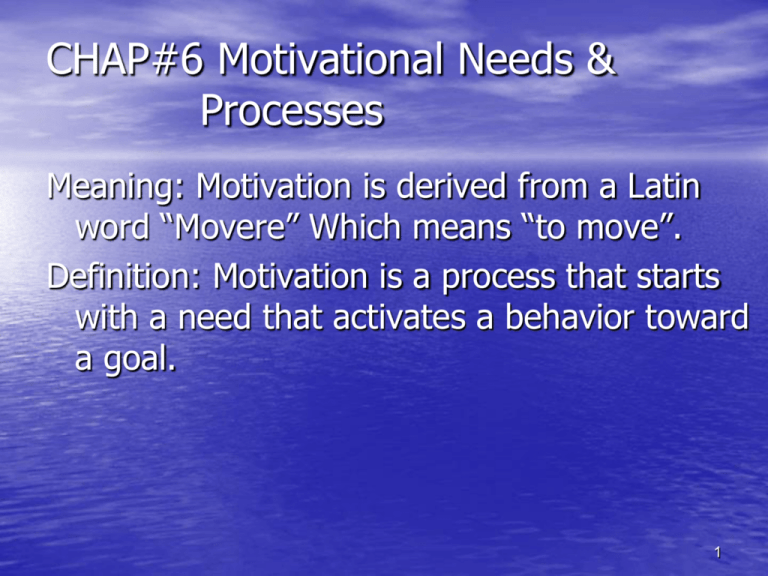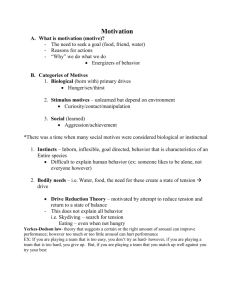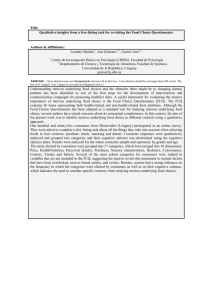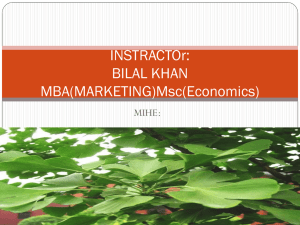CHAP#3
advertisement

CHAP#6 Motivational Needs & Processes Meaning: Motivation is derived from a Latin word “Movere” Which means “to move”. Definition: Motivation is a process that starts with a need that activates a behavior toward a goal. 1 Dimensions/ Elements of Motivation • Motivation consists of three interacting & interdependent elements. • NEEDS----- DRIVES------ GOAL(Incentive) • 1. NEEDS: are created whenever there is a physiological or psychological imbalance. For example, a need exists when cells in the body are deprived of food and water or when the personality is deprived of 2 Conti… Other people who serve as friends. Although psychological needs may be based on deficiency, sometimes they are not. For example, an individual with a strong need to get ahead may have a history of consistent success. 3 Conti… • 2. Drives: drives, or motives are set up to lessen needs. A physiological drive is a deficiency with direction. Physiological & psychological drives are action oriented and provide energy toward reaching an incentive. The examples of the needs for food and water are translated into the hunger and thirst drives, and the need for 4 Conti… • Friends becomes a drive for affiliation. • 3. Incentive (Goal): At the end of the motivation cycle is the incentive. It is defined as anything that will lessen a need and a drive. Thus, attaining an incentive is to restore physiological or psychological balance and will reduce or cut off the drive. Eating food, drinking 5 Conti… • Water, and obtaining friends will tend to restore the balance. Food, water, and friends are the incentives in these examples. 6 Classification of Motives • 1. Primary Motives: these are physiological, biological & unlearned motives. • Examples: hunger, thirst, sleep, avoidance of pain, sex, maternal concern & the role that the brain may play in people motives. 7 2. General Motives • These are the motives between primary & secondary motives. To be included in the general category , a motive must be unlearned but not physiologically based. General needs are sometime called “stimulus motives”. • Examples: interest, handling, activity, & possibly affection. 8 3. Secondary Motives • Secondary Motives are learned motives. They are the most important motives. • As a human society develops economically & becomes more complex, the primary drives, & to a lesser degree the general drives, give way to the learned secondary drives in motivating behavior. The motive of hunger & thirst are not dominant 9 Conti… • Among people who live in the economically developed world. 10 Examples of Key Secondary Needs • 1. Need for Power: (a) Influencing people to change their attitude, or behavior (b) Controlling people & activities (c) Being in a position of authority over others (d) Gaining control over information & resources 11 Conti… (e) Defeating an opponent, or enemy 2. Need for Achievement: (a) Doing better than competitors (b) Attaining a difficult goal (c) Solving a complex problem (d) Carrying out a challenging assignment successfully 12 Conti… (e) Developing a better way to do something 3. Need for Affiliation: (a) Being liked by many people (b) Being accepted as part of a group or team (c) Working with people who are friendly & cooperative 13 Conti… (d) Maintaining harmonious relationships & avoiding conflicts (e) Participating in pleasant social activities 4. Need for Security: (a) Having a secure job (b) Being protected against loss of income (c) Having protection against illness & disability 14 Conti… (d) Being protected against physical harm (e) Avoiding tasks or decisions with a risk of failure & blame 5. Need for Status: (a) Having the right car & wearing the right clothes (b) Working for the right company in the right job 15 Conti… (c) Having a degree from a right university (d) Living in the right neighborhood & belonging the country club (e) Having Executive privileges 16






